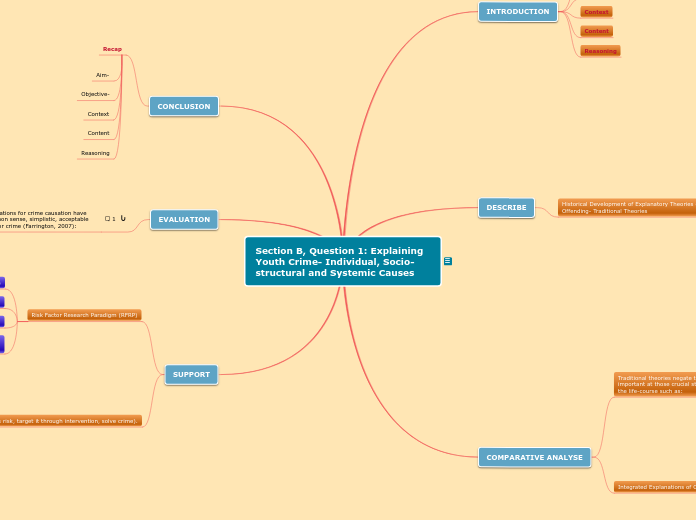Section B, Question 1: Explaining Youth Crime- Individual, Socio-structural and Systemic Causes
INTRODUCTION
Aim-
Objective-
Context
Content
Reasoning
DESCRIBE
Historical Development of Explanatory Theories of Youth Offending- Traditional Theories
Individual Explanations
Classicism-
Crime occurs due to 'rational choice'
Gives rise to crime control strategies.
Biological Positivism-
Crime occurs due to determined factors at the physiological level and biological levels.
Crime can be treated and the individual rehabilitated.
Socio-structural Explanations
Positivism
Crime occurs due to determined factors at the sociological and psychological levels.
Critical Explanations
Draws on the concept of 'Power'- "By pointing to power without analyzing its class basis and the nature of the state, [the sociologists of deviance and labeling theorists] transformed the actions of the powerful into an arbitrary flexing of muscle" (Young, 1978:13).
Critical Theories
Power to Criminalise/De-criminalise certain forms of behaviour.
Power to evade criminalisation.
Labelling
Structural inequalities becomes institutionalized within the operation of the law and the wider working of the state.
Crime as the product of socio-political conditions which are influenced by the political interests of those who seek to maintain their position.
Focus is on the activities of the powerless whilst obscuring their ability to exploit their own privileged position.
COMPARATIVE ANALYSE
Traditional theories negate the varying factors that are important at those crucial stages of development throughout the life-course such as:
How early childhood experiences and family experiences can impact on later behaviour.
Intertwining of personal factors, social factors, socialization factors, cognitive factors, and situational factors
Integrated Explanations of Crime
Integrated Positivist Theories
Sociobiological theories
Social Control theories of crime
Integrated Risk Factor Theories
Artefactual Risk Factor Theories
Enhanced Pathways Risk Factor Theories
Socio-Political Context
According to Case et al, (2017), this:
“socio-political risk perspective began to gain popularity within criminology in the industrialised western world” (2017:511).
CONCLUSION
Recap
Aim-
Objective-
Context
Content
Reasoning
EVALUATION
RFR assert that their explanations for crime causation have validity- that they are common sense, simplistic, acceptable and practical explanations for crime (Farrington, 2007):
Case (2016: online) suggests the ‘evidence’ comes from an endless stream of self-fulfilling, repetitive risk factor research studies and experimental, risk-based ‘what works interventions.
Incestuous, pseudo-psychological, Americanised, over-simplified and dehumanising. Privileging this model to the relative exclusion of alternatives (e.g. actually talking to children about their experiences and understandings) ” (2016: online):
SUPPORT
Risk Factor Research Paradigm (RFRP)
Multi-Factor Developmental Theory (Glueck and Glueck, 1930)
The Criminal Career Model (West and Farrington, 1973)
Dual Taxonomy (Moffitt, 1990)
Age-Graded Theory of Informal Social Control (Sampson and Laub, 1993)
Assess risk, target it through intervention, solve crime).
Test their validity and the common claims they make:
The readily understandable findings of RFR have now become embedded in the Youth Justice system in terms of policy and practice and a ready set of targets for intervention.
Focus of both assessment and intervention shifted from the child to the general environment, the family, and the school environment.
The approach has come to dominate assessment, planning and intervention tools for the identification of ‘factors’ in an attempt to predict ‘risk’
Asset
AssetPlus
Onset
